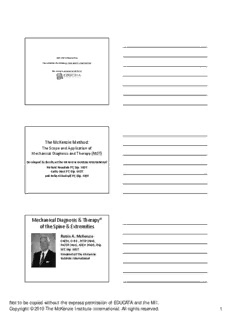
McKenzie Method APA - EDUCATA PDF
Preview McKenzie Method APA - EDUCATA
WelcometoMyLearning TheAustralianPhysiotherapyAssociation’se‐learningsite TThhiissccoouurrsseeiissppoowweerreeddbbyyEEDDUUCCAATTAA The McKenzie Method: The Scope and Application of Mechanical Diagnosis and Therapy (MDT) Developed by faculty at the McKenzie Institute International: Richard Rosedale PT, Dip. MDT Kathy Hoyt PT, Dip. MDT and Robert Medcalf PT, Dip. MDT Mechanical Diagnosis & Therapy® of the Spine & Extremities Robin A. McKenzie CNZM, O.B.E., FCSP (Hon), FNZSP (Hon), NZCP (HLM), Dip. MMTT, DDiip. MMDDTT President of The McKenzie Institute International Not to be copied without the express permission of EDUCATA and the MII. Copyright ©2010 The McKenzie Institute International. All rights reserved. 1 Outline Section 1 Section 2 • History and background • The natural history of • Institute and musculoskeletal eedduuccaattiioonnaall pprrooggrraamm ccoonnddiittiioonnss • Principles, evidence • The need for overview classification • An outline of MDT classification Outline Section 3 Section 4 • Assessment • Case examples overview •• PPrriinncciipplleess ooff management Section 5 • Summary History of MDT • Robin McKenzie • Mr. Smith • Key to effective therapy – Education – Self‐treatment Not to be copied without the express permission of EDUCATA and the MII. Copyright ©2010 The McKenzie Institute International. All rights reserved. 2 Disc Model Flexion Extension Nuclear Movement The next slide shows nuclear movement occurring in the lumbar spine in a laboratory setting. Nuclear Movement Sheppard J, Rand C. “Internal disc dynamics: a study of 100 specimens.” Hastings, England. Not to be copied without the express permission of EDUCATA and the MII. Copyright ©2010 The McKenzie Institute International. All rights reserved. 3 McKenzie Institute • Founded in 1982 • Located in RaumatiiBeachh, New Zealand • 27 branches worldwide McKenzie Institute International United States Denmark Netherlands Argentina Finland New Zealand Brazil France Nigeria Canada Germany Poland Australia Hellas/Cyprus Saudi Arabia Austria Hungary Slovenia Belgium Italy Sweden Croatia Japan Switzerland Czech Republic Luxembourg United Kingdom McKenzie Institute • 80 teaching faculty • Roles of edducatiion, researchh, promotion Not to be copied without the express permission of EDUCATA and the MII. Copyright ©2010 The McKenzie Institute International. All rights reserved. 4 Mechanical Diagnosis and Therapy® A unique, dynamic and comprehensive syystem of assessment, classification, treatment and prevention for musculoskeletal disorders. Mechanical Diagnosis and Therapy® not simply extension exercises… Mechanical Diagnosis and Therapy® exploring different loading strategies, postures and movements… Not to be copied without the express permission of EDUCATA and the MII. Copyright ©2010 The McKenzie Institute International. All rights reserved. 5 Mechanical Diagnosis and Therapy® to classify and treat musculoskeletal conditions. What Is the McKenzie System of Mechanical Diagnosis & Therapy (MDT)? Diagnostic – Reliability Prognostic – Validity Therapeutic – Dx/Rx link Client‐centered – Patient empowerment Prophylactic – Prevent recurrences Mechanical Diagnosis & Therapy® (MDT) Positions MMoovveemmeennttss Postures Activities Not to be copied without the express permission of EDUCATA and the MII. Copyright ©2010 The McKenzie Institute International. All rights reserved. 6 Mechanical Diagnosis & Therapy® (MDT) Reliable Patient‐generated assessment exercises AAAA DDDD TTTT OOOO Valid classifications Better outcomes when treatment matched to classification Spratt 2002. Reliability Studies on MDT 15+painresponsestudies=goodreliability • Clare 2004, 2005 • Dionne 2006 • Kilpikoski2002 • Laslett2003 • May 2009 Diagnosis • Petersen 2003, 2004 • Seymour 2003 Assessment • Razmjou2000 • Werneke1999 The McKenzie Institute® Education & Certification Program • Part A: Lumbar spine • Part B: Cervical & thoracic spine • Part C: Advanced lumbar spine and extremities: lower limb • Part D: Advanced cervical spine and extremities: upper limb • Credentialing examination • MII Diploma Program • In the United States: Fellowship in MDT/OMPT Not to be copied without the express permission of EDUCATA and the MII. Copyright ©2010 The McKenzie Institute International. All rights reserved. 7 Centralization reliability Five studies • Agreement –88% to 100% • Kappa –0.51 to 0.96 • Kappa –4 studies > 0.70 • Good to very good reliability • Level of training influenced the results Extremities reliability • Classification –Kappa: 0.84 (May and Ross 2009) Clinical Subgroup Studies observational,caseseries,prognostic,diagnosticvalidation,surveys Studies: Alexander1992;Brotz2010;Bybee2005;Clare 2007;Donelson1990,1991,1997;Erhard1994; Fritz2007;George2005;Hefford2008;Karas 1997;Kopp1986;Laslett2005;Long1995,May 2006,2008(Rasmussen2005);Skytte2005; Sufka1998;Young2003;Werneke1999,2001, Treatment 22000033,22000044,22000055,22000088 Reviews: Diagnosis Aina&May2004;Berthelot2007;HancookMay 2006,2007,2008;Udermann2004;Wetzel 2005,May&Donelson2008;Machado2006; Peterson1999 30+ centralization/DP publications Not to be copied without the express permission of EDUCATA and the MII. Copyright ©2010 The McKenzie Institute International. All rights reserved. 8 Results prognosis • 6 studies reported on prognosis. • Outcomes for centralization subgroup compared to non‐centralization subgroup. • Treatments were based primarily on MDT principles. Results centralization Centralization was correlated with: • Good/excellent overall outcomes • GGrreeaatteerr rreedduuccttiioonn iinn ppaaiinn iinntteennssiittyy • Higher return‐to‐work rate • Greater functional improvement RandomizedClinicalTrialswithSubgroups MDT,centralization,directionalpreference • Brennan 2006 Out‐ • Browder 2007 comes • Brotz2007 Treatment •• DDeelliittttoo11999933 • Fritz 2003, 2007 • Long 2004 • (Spratt 1993) Not to be copied without the express permission of EDUCATA and the MII. Copyright ©2010 The McKenzie Institute International. All rights reserved. 9 Treatment AAAA DDDD TTTT OOOO Building Evidence Outcomes Treatment Diagnosis Assessment Not to be copied without the express permission of EDUCATA and the MII. Copyright ©2010 The McKenzie Institute International. All rights reserved. 10
Description: